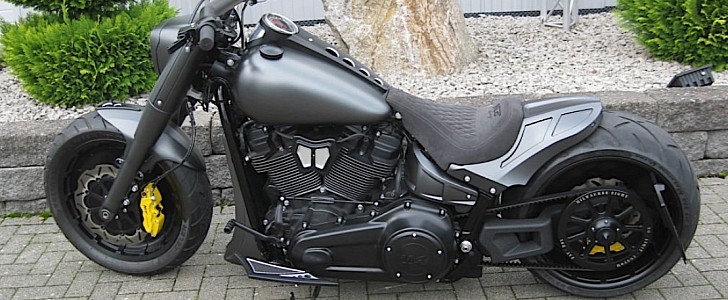Harley-Davidson describes its current generation Fat Boy as the “original fat custom icon, now with bright chrome finishes.” That because chrome is what people are after these days, in various quantities, as a means for them to stand out in a crowd.
The bike you’re looking at is an older example of the breed, and it stands out in a crowd too. Only it does so not on account of chrome parts, but because it lacks them altogether.
The build is the work of a German custom shop by the name of No Limit Custom (NLC). It’s a pretentious project, one that is worth around 11,000 euros, which is roughly $13,000 at today’s exchange rates. To put that in perspective, consider Harley is charging one dollar short of $20k for a brand new Fat Boy.
The thing that stands out first about this project is, of course, the matte paint chosen for it. Various shades of black and grey cover the entirety of the motorcycle, the single exception being the yellow brake calipers.
Despite looking particularly menacing, it's not the paint that cost that much on this build – in fact, it is not included in the amount we mentioned earlier. It’s all those different custom parts used on the build that nearly double the motorcycle’s value.
The most expensive of them all, at around $4,250, is the single-sided swingarm kit fitted on the build. Then comes the aluminum rear fender, which alone is worth $2,530. Various other components, like the front fender, covers, handlebars or running boards made up for the difference – you can view the whole list of parts used at this link.
NLC makes no mention of any modifications made to the two-wheeler’s powerplant, the famous Milwaukee Eight, which probably means most of the changes do not target or affect the bike’s performance.
The build is the work of a German custom shop by the name of No Limit Custom (NLC). It’s a pretentious project, one that is worth around 11,000 euros, which is roughly $13,000 at today’s exchange rates. To put that in perspective, consider Harley is charging one dollar short of $20k for a brand new Fat Boy.
The thing that stands out first about this project is, of course, the matte paint chosen for it. Various shades of black and grey cover the entirety of the motorcycle, the single exception being the yellow brake calipers.
Despite looking particularly menacing, it's not the paint that cost that much on this build – in fact, it is not included in the amount we mentioned earlier. It’s all those different custom parts used on the build that nearly double the motorcycle’s value.
The most expensive of them all, at around $4,250, is the single-sided swingarm kit fitted on the build. Then comes the aluminum rear fender, which alone is worth $2,530. Various other components, like the front fender, covers, handlebars or running boards made up for the difference – you can view the whole list of parts used at this link.
NLC makes no mention of any modifications made to the two-wheeler’s powerplant, the famous Milwaukee Eight, which probably means most of the changes do not target or affect the bike’s performance.









